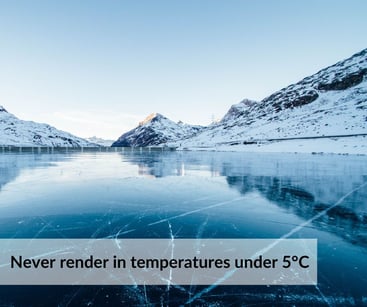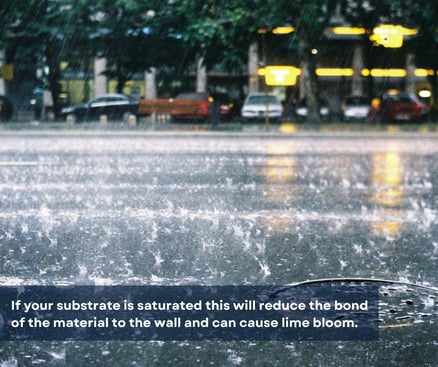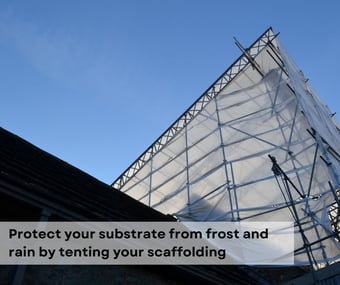British weather; how often do we check, discuss or moan about it? If you're a renderer being on the daily weather watch is simply part of the job to ensure a sound and flawless render application. As well as looking after your wall, materials and machines or tools, it important to also look after yourself in colder temperatures and dress appropriately. Find out why you need to take extra care when rendering in cold weather and our top tips on rendering in winter below.
Ice, Ice Baby
Rendering should always be carried out in temperature of 5°C + and should never be done in frosty conditions. If your substrate is lined with frost this will affect the bond of the material to the wall. Also, since water is added to pre-bagged plaster and water freezes at 0°C, be aware that freezing temperatures can affect your material and therefore the structural integrity of it. Take into account your water feed too as water from the mains may be too cold; we would suggest using a water butt.

You should consider the weather surrounding the day you're applying. Your substrate can retain freezing temperatures for longer than you think especially if it's been a prolonged cold spell. Lengthy periods of cold weather can mean that your render does not fully dry. This is because the water cannot evaporate and moisture becomes trapped in the material; slower water absorption compromises strength. It is also important to check the subsequent days to ensure you're allowing at least 48 hours of drying time at about 5°C. Try and keep temperatures as constant as possible since fluctuations can cause movements in the substrate.
Wet, Wet, Wet

Rendering in the rain is also a no, no if you're not adequately protected. Rain can cause inconsistencies in the render, weak material as well as wash the render off entirely. If your substrate is saturated this with reduce the bond of the material to the wall and can cause lime bloom. Lime bloom occurs when render is exposed to damp or low temperatures in early curing stages. The cement in render does not work well with damp and slow drying conditions and a thin white film can form on the surface. Whilst lime bloom does not affect the structural integrity of your render it looks somewhat unsightly. If the wall is saturated, shrinkage whilst drying can cause movement and subsequent cracking of your render.
Our Top Tips on Coping in the Cold
Wrap Up: Working outdoors can have it's benefits when you're working in the sunshine on a beautiful spring day. However, there are the downsides of working outside when it comes to winter. It's important to keep yourself warm by wearing suitable insulated clothing including socks, boots and gloves. Wearing multiple thin layers is also advisable so you can remove or add to if you warm up/cool down. Keep a stock of barrier cream or moisturiser in your toolbox to protect your skin.
Storage: It is crucial to store your material correctly keeping it raised (on pallets) and away from cold floors. You may find that that keeping it closer to buildings is slightly warmer or ideally keep in storage. Equally keep your tools stored somewhere warmer to ensure they remain flexible and easier to work with when applying and finishing. Keeping them indoors also protects from frost, rain and potential ice. When cleaning your tools in winter ensure you dry them sufficiently so any water doesn't freeze.

Protect your substrate: In order to protect the wall from frost or rain both prior and post application, tent your scaffolding which protective sheeting whether that be tarpaulins, close mesh netting, polyethene or debris netting. Any sheeting should hang clear of the wall but so it is not forming a tunnel as this can create a channel of wind and increase the evaporation of water from the render.
Raise the Temperature: You could raise the temperature with the use of heaters however should ensure they are not directly pointed to the wall. The other way to trick your render into thinking it's a 20°C summer day is by using accelerator. Accelerator is an additive which is used at the mixing stage and speeds up the curing time.
If you're ever in doubt on whether it is too cold to render or you don't have a clear window of warm enough curing weather, it is always best to postpone rather than risk a sub-standard render. Consider as to whether you could continue on another part of your project for example working indoors with screeding floors.



